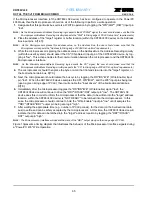
xr
PRELIMINARY
XRT86VL38
REV. P1.0.6
OCTAL T1/E1/J1 FRAMER/LIU COMBO
62
3.3
Operating the Microprocessor Interface in the PowerPC 403 Mode
If the Microprocessor Interface has been configured to operate in the PowerPC 403 Mode, then the following
Microprocessor Interface pins will assume the role that is described below in Table below:
T
ABLE
7: M
OTOROLA
A
SYCHRONOUS
M
ODE
M
ICROPROCESSOR
I
NTERFACE
T
IMING
S
PECIFICATIONS
S
YMBOL
P
ARAMETER
M
IN
M
AX
U
NITS
t
0
Valid Address to CS Falling Edge
0
-
ns
t
1
CS Falling Edge to DS (Pin RD_DS) Assert
65
-
ns
t
2
DS Assert to DTACK Assert
-
90
ns
NA
DS Pulse Width (t
2
)
90
-
ns
t
3
CS Falling Edge to AS (Pin ALE_AS) Falling Edge
0
-
ns
T
ABLE
8: T
HE
R
OLES
OF
V
ARIOUS
M
ICROPROCESSOR
I
NTERFACE
P
INS
,
WHEN
CONFIGURED
TO
OPERATE
IN
THE
P
OWER
PC M
ODE
P
IN
N
AME
420 P
KG
B
ALL
#
484 P
KG
B
ALL
#
T
YPE
D
ESCRIPTION
ALE
R22
P22
I
Address Latch Enable Input - ALE
No Function - Tie to GND
RD*/DS*/
WE*
W25
U21
I
Write Enable Input - WE*
If the Microprocessor Interface is operating in the Power PC 403 Mode, then this
input pin will function as the WE* (Write Enable) input pin. Anytime the Micro-
processor Interface samples this active-low input signal (along with CS* and
WR/R/W*) also being asserted (at a logic low level) upon the rising edge of
PCLK, then the Microprocessor Interface will (upon the very same rising edge of
PCLK) latch the contents on the Bi-Directional Data Bus (D[7:0]) into the "target"
on-chip register or buffer location within the XRT86VL38 device.
RDY*/
DTACK*/
RDY
V24
R19
O
Active High READY Output - RDY
If the Microprocessor Interface has been configured to operate in the Power PC
403 Mode, then this output pin will function as the "active-high" READY output.
During a READ or WRITE cycle, the Microprocessor Interface block will toggle
this output pin to the logic high level, ONLY when it (the Microprocessor Inter-
face) is ready to complete or terminate the current READ or WRITE cycle.
Once the Microprocessor has sampled this signal being at the logic "high" level
(upon the rising edge of PCLK), then it is now safe for it to move on and execute
the next READ or WRITE cycle. If (during a READ or WRITE cycle) the Micro-
processor Interface block is holding this output pin at a logic "low" level, then the
Microprocessor is expected to extend this READ or WRITE cycle, until it sam-
ples this output pin being at the logic low level.
N
OTE
: The Microprocessor Interface will update the state of this output pin upon
the rising edge of PCLK.






























